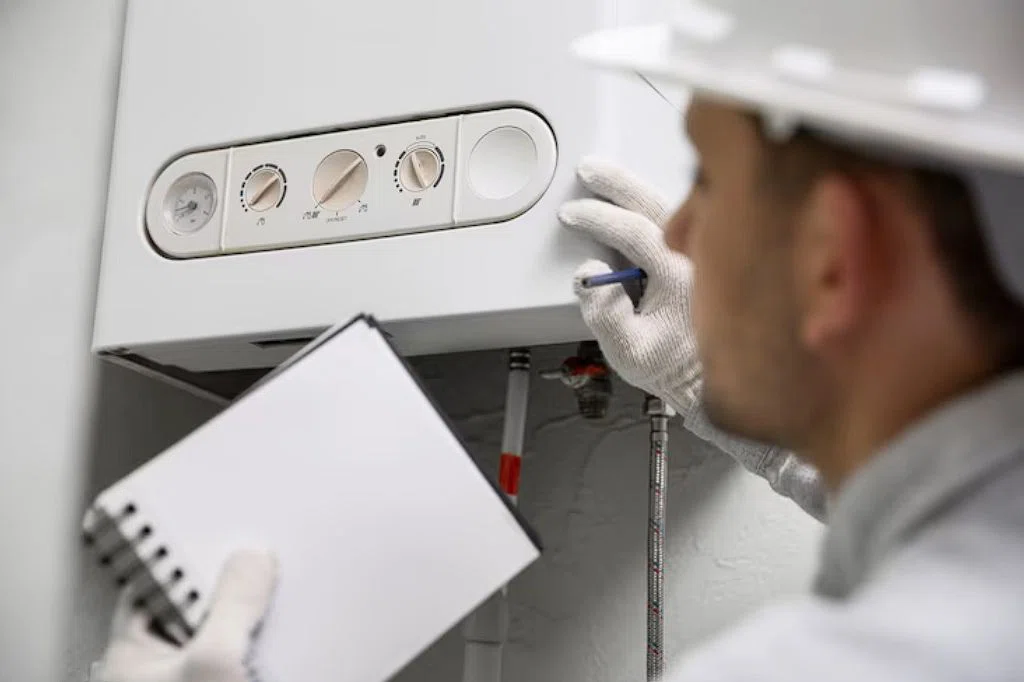
Geyser: replacement, installation and safety in your apartment
Learn about the importance of replacing and installing a geyser in an apartment. Detailed replacement steps, requirements and documents. Safety and efficiency of gas equipment operation. Contact the professionals to keep your home safe.
Content
- Who has the right to connect the gas heater
- Basic requirements for the room and installation of the gas heater
- For the correct installation of a gas heater, several important parameters must be taken into account. Here are some of them
- Steps to replace a gas heater for your convenience
- Frequently Asked Questions
- ❓ When should I replace my gas heater?
- ❓ How do I choose a new gas heater?
- ❓ Can I replace a gas heater myself?
- ❓ What safety precautions should I take when replacing a gas heater?
- ❓ What to do if gas leaks are detected during the replacement process?
When a renovation is carried out in the apartment, there is a desire to replace all household appliances with new and modern ones, including the gas heater. However, this is only one of the reasons why you should think about replacing this equipment. Gas column requires replacement every 10-15 years: it becomes outdated, often breaks down, and the use of old or faulty equipment can be dangerous to life and health. Many people mistakenly believe that a gas heater can be installed by any locksmith, but this is far from true.
In this article we will tell you who can install and start up a gas heater, what documents need to be prepared and what requirements need to be met.
Who has the right to connect the gas heater
It is forbidden to carry out the replacement of the gas heater on your own, according to the legislation, for such actions there is a fine from 315 to 475 Georgian GEL. Moreover, if as a result of improper installation of the device material damage was caused to other residents or someone was injured, it is possible to be held administratively or criminally liable. The State Gas Company annually inspects the installation and operation of the gas heater, so it is impossible to hide the fact of installation of a new and unregistered device.
Installation and dismantling of a gas heater can be performed only by specialized organizations, such as GORGAS or private companies that have a license for this type of activity.
Basic requirements for the room and installation of the gas heater
The basic requirements for the room and installation of the gas heater are an integral part of the safety and reliability of this equipment. The Code of Regulations approved by the State Construction Committee contains detailed information defining the norms and standards to be followed when selecting a location for the installation of a gas heater and when carrying out its installation.
First of all, attention should be paid to the choice of room for the installation of a gas heater. It is noted that this device can only be placed in non-residential premises. This means that studio apartments, living rooms and bedrooms are not suitable places for installing a gas heater. This restriction is due to the need to ensure the safety of the occupants and to prevent possible dangerous situations. It is also worth noting that it is not recommended to install a gas heater in houses with more than 11 floors, or above cooking surfaces where there is a high probability of an explosive situation.
An important factor in choosing where to install a gas heater is the material the walls are made of. The walls must be fire resistant and have the necessary strength. For example, concrete and brick are suitable materials. It is important to note that it is forbidden to install the gas heater on load-bearing walls and structures, as well as on plastic panels and partitions made of hollow bricks. However, it is possible to install a gas heater in wooden private houses, provided that the walls are additionally protected by a partition wall made of non-combustible materials. This ensures safe operation and prevents possible fires.
Particular attention should be paid to the ventilation of the room where the gas heater will be installed. Water heaters with an open type of combustion chamber require a chimney through which the combustion products are discharged. In the absence of a chimney is required to order a gas heater with a closed type of chamber, which will effectively remove the combustion products in a special channel in the wall. In addition, in the room where the gas heater is installed, there should be ventilation holes, as well as the possibility of ventilation through the window and door. This is necessary to maintain a normal level of air exchange and effective removal of exhaust gases.
If all of the above requirements for the room and installation of the gas heater are met, safe operation is ensured and the risks of dangerous situations are minimized. Regular inspection and maintenance of the gas heater are also essential measures to ensure the reliability and longevity of this equipment.
In addition to the above requirements, it is also important to pay attention to the quality of the gas heater and its compliance with safety standards. When choosing a gas heater, you should follow the manufacturer's recommendations and consult with qualified specialists. They will be able to help determine the most suitable model, taking into account the peculiarities of the room and installation requirements.
It is also important to take into account that the gas heater should be used only in accordance with its purpose and is designed to supply hot water. Operation of the gas heater for other purposes can lead to malfunction and increased risk of accidents. When operating the gas heater, it is advisable to observe the regulated maintenance and inspection periods in order to detect and eliminate possible malfunctions in good time.
In addition, it is worth noting that when installing a gas heater in the home, access to the main meter compartment and gas main shut-off valves should be provided. This will ensure the possibility of quick
There are several important parameters to consider for proper installation of a gas heater. Here are some of them:
- The volume of the room should be at least 7.5 square meters to provide enough space for the installation of the gas heater. Note that the room must be large enough to ensure proper ventilation and safety.
- The height of the ceilings should not be less than 2 meters. This is to ensure easy access to the heater and also to create a comfortable space in the room. High ceilings also promote better air circulation.
- The distance from the installed gas column to the ceiling should be 25-30 centimeters, and to the floor - 80-120 centimeters. These parameters are important to ensure the safety and efficient operation of the heater. Sufficient space at the top and bottom ensures proper ventilation and makes it easier to service the appliance.
- The gap between the body of the gas heater and the walls should be at least 2 centimeters. This gap is necessary to ensure proper air circulation around the heater and to prevent overheating. Make sure that the clearance corresponds to the specified value to ensure the safety and efficiency of the appliance.
In addition to these parameters, there are other factors to consider when installing a gas heater. Let's take a look at some of them.
- Type of combustion chamber: Depending on the type of combustion chamber of your gas heater, you may need a specific cabinet design to cover it. If you have an open chamber heater, the cabinet may have no top or bottom, but the side walls must be at least 15 centimeters away from the appliance. If you have a closed combustion chamber, the cabinet may have a top, bottom and side walls, but they must be 3 to 5 centimeters away from the heater.
- Gas Analyzer: For added safety, you can install a gas analyzer in the room. This is a device that can detect gas leaks and alert you if the level of propane in the air is exceeded. It is recommended that you install a gas analyzer for your peace of mind and to prevent potential accidents.
- Consult with professionals: When installing a gas heater, it is recommended that you contact experts or professional service providers. They will be able to provide expert knowledge and assistance in choosing the best configuration for your premises, taking into account specific requirements and parameters.
It is important to remember that a gas heater is a complex device that requires proper installation and maintenance. Follow these parameters and always seek the assistance of qualified professionals to ensure the safety and efficiency of your gas system.
Gas heater replacement steps for your convenience
The steps of replacing a gas heater is an important process that requires necessary preparation and following certain steps. In this article, we will review the steps of replacing a gas heater and provide you with useful information to help you successfully complete this procedure.
- Preparatory measures: The first step before replacing the gas heater is to collect the necessary documents.
- Documents confirming the ownership of housing
- Copy of the gas supply project
- Inspection report on the condition of ventilation and chimney
- Passport for the new gas heater
- Applications for replacement of the gas heater without changing its capacity and location
- Applications for a permit to work on water and gas mains
All of these documents are required to successfully carry out the replacement. If you need to change the location or choose a more powerful model of heater, a new gas supply project will be required.
- Selecting and installing a new gas heater. After the preparations, a gas service worker or a licensed company's technician must be called to remove the old gas heater and install the new one. The process of removing the old heater usually involves some cost, which may vary depending on the region and conditions. The cost of installing a new heater also depends on the model chosen and can be estimated between 100 and 200 GEL.
- Registration and commissioning. After installing a new gas heater, it is necessary to call a gas service inspector to register it, if the work was performed by a specialist from a licensed company. The inspector will check the compliance of the installed heater with technical and safety requirements. This requires technical documentation from the installer. After checking and satisfying the requirements, the inspector will authorize the start-up of the water heater. He will then make a note in the technical passport and issue a commissioning certificate.
After successfully replacing the gas heater, it is important to remember to maintain it regularly. Regular inspection and maintenance guarantees safe and efficient operation of the installed equipment. It is advisable to contact professionals to carry out periodic maintenance and correct possible malfunctions.
Replacing a gas heater can lead to improved economic efficiency and reduced environmental impact. Modern gas heaters are highly energy efficient, which helps to reduce energy costs and lower emissions. When choosing a new heater, it is advisable to pay attention to its energy efficiency and compliance with environmental standards.
Thus, replacing a gas heater requires organizing and following certain steps. From document preparation to registration and maintenance, each step plays an important role in ensuring the safety and efficient operation of your gas heater. Remember the importance of contacting professionals to carry out this procedure and to maintain your equipment on a regular basis.
Frequently Asked Questions
❓ When should a gas heater be replaced?
💡 It is recommended to replace a gas heater when it has failed, has significant breakdowns, or has exceeded its recommended lifespan, usually around 10-15 years.
❓ How do I choose a new gas heater?
💡 When choosing a new gas heater, consider necessary features such as wattage, the right type of gas (natural or bottled), boiler capacity and energy efficiency. Contact professionals to get advice and choose the right model.
❓ Can I replace a gas heater myself?
💡 Replacing a gas heater requires experience and knowledge of plumbing and gas installations. It is recommended that you contact a qualified professional to ensure the safety and proper installation of your new heater.
❓ What safety precautions should I take when replacing a gas heater?
💡 Always turn off the gas valve and close the gas supply tap before starting to replace the gas heater. Only work on the heater in a ventilated area and use the correct tools and fixtures for the installation.
❓ What should you do if gas leaks are detected during the replacement process?
💡 If you discover a gas leak while replacing the gas heater, stop work immediately, turn off all sources of spark and call the gas service for immediate repair.







5 comments
Log in to leave a comment
Если вам предстоит замена данного оборудования, то из этой статьи вы узнаете как и кто производит замену газовой колонки, какие для этого нужны документы, и как выбрать подходящий вариант прибора для вашего помещения.